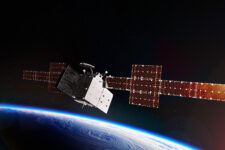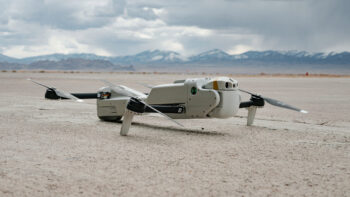
The Beaver moon is seen from the historic center on November 27, 2023 in San Salvador, El Salvador. (Photo by APHOTOGRAFIA/Getty Images)
WASHINGTON — DARPA has chosen 14 companies — ranging from launch providers to robotic vehicle makers to firms planning to transport cargo around cislunar space — to undertake a study on the types of technologies needed to create a working lunar economy, the Pentagon’s far-future research agency announced today.
The 10-Year Lunar Architecture (LunA-10) Capability Study “aims to catalyze the setup of a future civil lunar framework for peaceful U.S. and international use,” DARPA said in a statement. The study will promote development of technologies and operational concepts that, when integrated, will form the basis of a sustainable and profitable economic ecosystem linking the Earth and Moon.
“LunA-10 has the potential to upend how the civil space community thinks about spurring widespread commercial activity on and around the Moon within the next 10 years,” said Michael “Orbit” Nayak, program manager in DARPA’s Strategic Technology Office. “LunA-10 performers include companies both big and small, domestic and international, each of which brought a clear vision and technically rigorous plan for advancing quickly towards our goal: a self-sustaining, monetizable, commercially owned-and-operated lunar infrastructure.”
The companies tapped by DARPA will work together over the next seven months “in a highly collaborative environment, where they will design new integrated system-level solutions that span multiple lunar services. These include lunar power; mining and commercial in-situ resource utilization; communications, navigation, and timing; transit, mobility, and logistics; and construction and robotics,” the agency’s release explained. Those companies are: Blue Origin; CisLunar Industries; Crescent Space Services LLC; Fibertek, Inc.; Firefly Aerospace; GITAI; Helios; Honeybee Robotics; ICON; Nokia of America; Northrop Grumman; Redwire Corporation; Sierra Space; and SpaceX.
For example, launch startup Firefly will contribute to LunA-10 with “a framework for on-orbit spacecraft hubs,” the company said in a press release. “Based on the capabilities of Firefly’s Elytra vehicle, the framework will define how spacecraft can dock together on-orbit and provide on-demand services, such as refueling, delivery, transport, and de-orbiting. The goal of the framework is to help improve on-orbit mission response times from years to days with scalable spacecraft hubs that can host and service spacecraft across cislunar space.”
The effort is an outgrowth of the Biden administration’s National Cislunar Science and Technology Strategy [PDF] released in November 2022 designed to build a whole-of-government strategy for “advancing scientific, exploration, and economic development activities” in space around the Moon and on the lunar surface. The Defense Department was a key player in the strategy’s crafting, and thus reflects a number of the Space Force’s priorities for the future — including space situational awareness in the lunar region and “dynamic space operations” requiring rapid, efficient maneuvering on orbit.
DARPA’s announcement makes clear the effort does not include funding for the actual production and deployment of related tech, nor will it “support human exploration or scientific experimentation that does not have a commercial value.” The goal, rather, is to help commercial industry help itself. And the winners, it seems, are just fine with that.
“It is inspiring to see DARPA doing what it does best – moving fast on hard problems and catalyzing commercial innovation for the good of the country and humanity,” said ICON co-founder and CEO Jason Ballard in a press release. ICON specializes in advanced construction technologies and large-scale 3D printing.
Gary Calnan, CEO of CisLunar Industries, echoed: “DARPA finally did what the industry was waiting for. … This effort will lay the foundation for a marketplace where the entire space domain can participate.” Cislunar is focused on lunar mining, for example of precious metals, and “will facilitate the development of the METAL framework (Material Extraction, Treatment, Assembly & Logistics),” the company said in a press release.






















